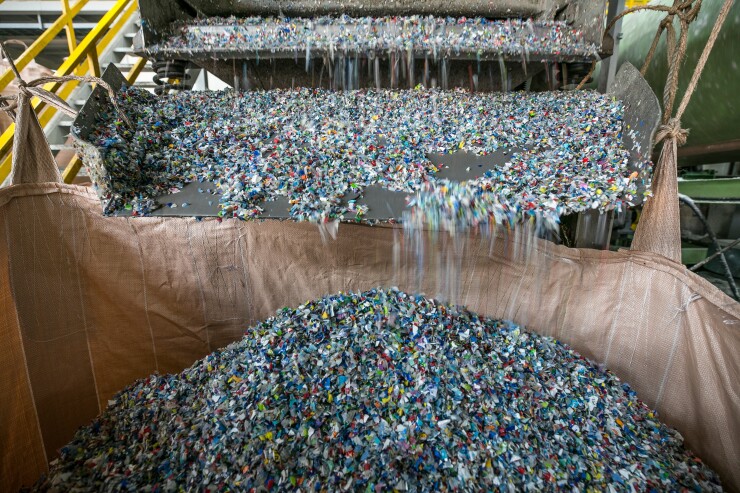
A tiny corner of the muni market made big promises but apparently failed to deliver.
When revenue bonds bearing a "green" label premiered just more than a decade ago, proponents argued the tax-free borrowing would fund environmentally friendly projects while satisfying a then-growing crop of investors trying to balance positive returns and palatable social impact.
But a slew of high-profile defaults has since chipped away at that chic veneer. The bonds now represent what is perhaps the riskiest corner of an already troublesome sector of the muni market, often acknowledged for impressive stability.
For some investors, the risk may be worthwhile, with the bonds filling a rather vacuous space in the high-yield market. The scientists who study the underlying technologies, though, worry financial failures are creating reputational risk, souring perceptions of what they believe may be important methods of combatting climate change.
'These are a yield play'
Munis bearing a "green" label emerged amid the growth of environmental, social, and governance (ESG) investment philosophies, which seek to augment traditional financial analysis with consideration of ethics and societal impact. Some analysts
But those predictions have turned out to misidentify the assets' true audience, said Eric Glass, CEO and founder of Clarion Capital, a municipal fixed-income investment firm focused on environmental and social equity.
The "green" label applied to industrial development munis is not a regulated designation. Issuers sometimes claim to adhere to best practices, but the true environmental impact of the projects are often not evaluated by a neutral outside party, as is common with corporate bonds labeled "green." That leaves some projects environmentally murky, or even
Glass said the ambiguity has deterred ESG investors from getting involved with the assets. Clarion does not hold any green revenue bonds, he said. When Glass led AllianceBernstein's municipal impact investment policy group, he said, his team did not buy them either, "generally speaking."
So, who is buying these green munis? Glass said they have found a home in high-yield portfolios, with investors attracted to the assets' potentially impressive returns.
The average 10-year municipal general obligation bond may yield little more than 3%. Revenue bonds, like for schools or airports, can get closer to 4%. Revenue bonds for projects promising environmental benefits often feature much higher returns, with recent green deals offering between 5% and 6%.
"These are a yield play," Glass said. "I don't see a lot of ESG or sustainable investors investing in these industrial development bonds."
The promised rewards of these bonds come with significant risks.
Currently about $6.8 billion of outstanding project financing bonds are marked "green." Of them, $611 million are in default, according to Matt Fabian of Municipal Market Analytics. That's a default rate of about 10%.
The muni market overall has a default rate that hovers around 0.05%. These green bonds live in a riskier subset of the market, where private entities issue through conduits. But even in that area, the default rate for all project financing bonds is still only about 2%, according to Fabian.
The default rate for green bonds is also higher when one major deal is excluded, Fabian said. When Brightline's $2.5 billion high-speed rail deal issued with a green label is not counted in the green issuance total, the default rate for green industrial development bonds is close to 15%.
Still, high-yield investors have been willing to take a chance on the assets, perhaps because they simply lack other options, said Dean Myerow, a former muni trader who now sometimes taps capital markets as a developer.
While the muni market has
"Bond firms are so hungry for high-yield that they're more willing to overlook credit challenges and check the green box," he said. "There is a ton of investor appetite for tax-free bond funds, but not enough product that's high-yield, so I think they loosen their standards."
Reputational Risk
These projects' status as a high-risk investment worries some scientists who study the underlying technology. They insist the methods are sound and important to combatting climate change, but fear that financial failures will erode trust in them.
The sector of sustainable projects that tap the muni market for funds is diverse, and each project has its own challenges, said Stephanie Lansing, director of the Bioenergy and Biotechnology Laboratory at the University of Maryland. It's dangerous to lump them together and write them off, she said.
One project proposed converting manure to a sort of natural gas, but the Wisconsin facility that tapped the muni market to fund the venture
While that process is simple in theory, said Mark Holtzapple, a professor of chemical engineering at Texas A&M University who studies biofuels, scaling it and purifying the gas to get it into the grid — as some green muni-funded projects have proposed — is difficult. Even when attempted at scale, biogas can be far more expensive than natural gas.
"The only reason they can do it is because there are people who want to be green and pay for that green gas," Holtzapple said.
Other green muni-backed projects have tried to create biofuels from animal biomass, like a facility in Mississippi that promised to make fuel from chicken fat, which
Projects funded by green munis have also promised to create energy from plastic waste, like a West Virginia facility that
Simply put, plastics come from oil and can be processed back into it, he said. The challenge is that the makeup of plastics varies widely, and the process for converting it into fuel differs for various types, Castaldi said.
Massive facilities can make this work by carefully sorting or accepting only specific kinds of plastic, he said. But when small facilities attempt the conversion, with "businesspeople who do not understand the technology," they often run into trouble with sourcing and sorting a usable input, Castaldi said. There are also
Green munis have also been used to fund fuel made from shredded tires and recovered construction wood, paperboard made from old corrugated containers and cups, steel made from scrap metal, and supposedly sustainable wood-pellets, to varying success. Universities have also issued green munis to fund development projects that promise environmental benefits.
As companies "that don't understand their technology" continue to enthusiastically raise money in the muni market and default at high rates, Castaldi said, he fears "the message is going to become, 'These technologies don't work.'"
"But that isn't true," he said, at least for the plastic pyrolysis he studies. "The inherent technology works, but the entire supply chain has to be set up properly.
"It gives a bad perception to the entire process, and then once the process has that reputation, no one is going to want to try to improve it and investigate it."
That could create a rift between the scientific community developing these processes and the financial industry needed to fund its proliferation, said Holtzapple.
"The conclusion often reached by the investment community has been that these things don't work, but that's the wrong conclusion." he said. Generally, it's the investors who did "a poor job of allocating their capital and choosing the projects," he said.





